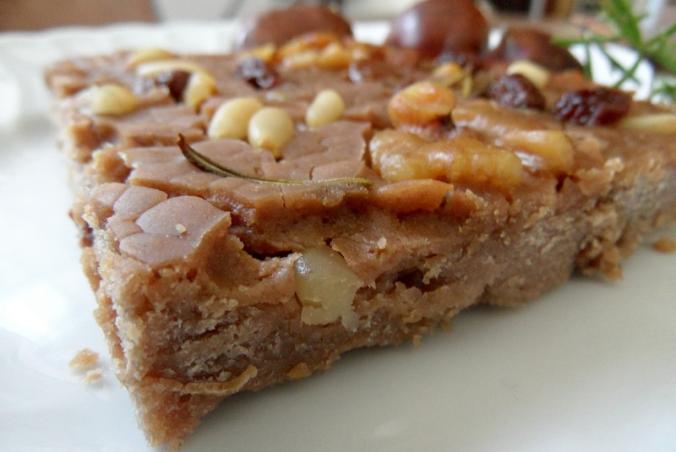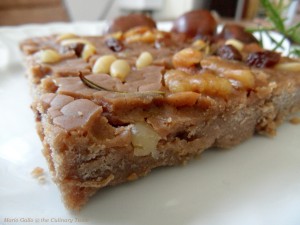Castagnaccio: the sugar-free and gluten-free Tuscan delicacy
December 01, 2013/in Blog/by admin
Castagnaccio is a typical Tuscan "cake" whose origins go back at least to the 16th century. It's easy to make, and both sugar-free AND gluten-free!
--------------------------------------------------------------------------------
Here's what you'll need:
400 g (3 1/4 c.) chestnut flour*
600 ml (2.5 c.) water
pinch of salt
80 g (1/2 c.) pine nuts
80 (1/2 c.) grams raisins
1 sprig fresh rosemary, roughly chopped
olive oil (about 6 tbls)
* you should find chestnut flour in your local natural food store, but North Americans can also order it online from Girolami Farms.
--------------------------------------------
1) pre-heat over to 200C (400 F) and let heat completely (1/2 hour)
2) grease a baking pan (I used a shallow quiche pan) with extra-virgin olive oil
3) pour warm water over the raisins to let them"plump" (then squeeze dry before using)
4) sift the chestnut flour to get rid of clumps (I didn't have a sifter so I just used a fork!)
5) add a pinch of salt, then gradually add the water to the flour until well-mixed and smooth
6) add MOST of the pine nuts and raisins (save a few to toss on top after baking)
7) pour into pan (should be 1 cm thick) and sprinkle with rosemary, then drizzle with olive oil
I didn't "drizzle" too evenly, so I swirled it around with a fork
8) bake for 30 mins or a bit longer until set (it will be moist like a brownie)
9) remove from oven and toss with remaining pine nuts and raisins
That's it! You can eat it any time, for breakfast, dessert or as a snack. You can also add some sugar if you want it a bit sweeter. You could even substitute chestnut flour for white flour in your favorite recipes. It's a low-glycemic food, totally gluten-free, rich in potassium, phosphorous, magnesium, folic acid, and vitamins C, B1 and B2. Tradition says it's also good for bronchitis, rheumatism, hemorrhoids, the common cold, and it's good for your hair and skin. What's not to like??
-----------------------------------------------------------------------------
Chestnuts are prevalent throughout the Mediterranean, and have been used as an important foodstuff for millennia. The flour was commonly used in places where there was no wheat (much of Tuscany as well as Liguria, for example). They've been cultivated by the Greeks, Phoenicians, Romans, and then by monks during the Middle Ages.
Now they are commonly eaten as a snack, either roasted or baked, and you'll find vendors in the streets of Florence selling the warm nuts in little paper cones. And of course, they are best paired with a glass of red wine!
Buon appetito!














